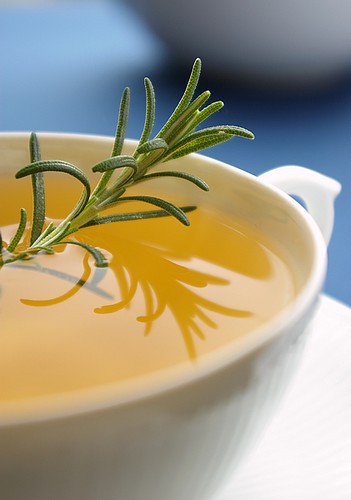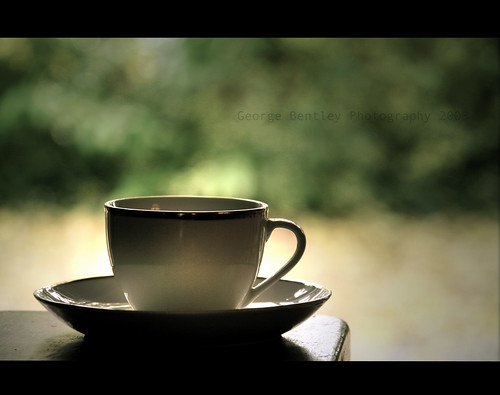Camellia Japonica, Tsubaki, originally uploaded by ROSS HONG KONG.
Although tea flowers are not used in perfumery for their fragrance (something I cannot comment on since I am yet to smell a true living tea flower), there is a surprising number of flower notes that closely resemble tea or have a dominant tea note in their evolution. Than there are the less conventional flowers that may not be universally perceived like tea, but have a honeyed, hay-like black-tea aspect that can be utilized to create a a dark tea ambiance.
Tea-Like Florals:
Floral tea-like notes include flower notes that closely resemble tea or have a dominant tea note in their evolution (interestingly, a significant portion of these contain ionones):
Osmanthus
This flower, rich with carotenes, has an aroma reminiscent of apricots, leather and green tea. A beautiful scent from the tiny white flowers from a Chinese tree from the olive and lilac family. Osmanthus has a rich and complex scent, combining green tea, leather and apricot notes – sweet, fresh and leathery all at once. The yield of Osmanthus is pretty low – 3,000 kilos of flowers yield one kilo of absolute, and it is therefore one of the more expensive materials in perfumery. Osmanthus is rarely used in mainstream perfumery; you're more likely to find it in niche perfumes and very upscale ones i.e.: the dense 1000 de Patou, the sheer, peppery tea veil of Hermessence Osmanthe Yunnan, and the even lighter Osmanthus by Ormonde Jayne.
Boronia
Rich with ionones, boronia has a scent reminiscent of yellow freesia, green tea and raspberry.
My first creation with boronia, a soliflore I named "Eau de Tinkerbell" (it was very bright green in colour and with a cheerful character, hence the name) relied on tea as the base note. The two definitely enhance each other. If osmanthus is rare, boronia is even rarer. You won't find it in many perfumes at all, and you're more likely to find it among the creations of natural perfumers.
Linden Blossom
Not so much floral as it is green, honeyed, woody and reminiscent of both tea and hay with a hint of fruitiness. Just like tea, it stays cool and quiet. It is not a coincedence that the first theme for my perfumed teas was linden, to accompany the launch of Tirzah. While linden blossom is not so popular as a single note (Tilleul by Roger et Gallet and Lime Blossom by Ormonde Jayne are the only two I can think of that put linden blossom in the limelight), it works really well within tea-like compositions in general (i.e.: in Kinmokusei).
Tea Rose
Originated in China and usually orange in colour, Tea Roses have beta carotenes and ionones which make them smell fresh and dewy and tea-like. I just recently came across the essential oil of such rose (Rosa odorata) and created a scent inspired by that - Tea Rose with ionones derived from osmanthus, and with the added accent of green tea.
Dark Tea Flowery Notes
And the following herbaceous, spicy, honeyed, somewhat earthy florals:
Champaca
The golden-glow of this Indian magnolia is not only in its colour but also in its backdrop of cured black tea leaves. Champaca evokes simultaneously red ripe berries, orange blossom, spices and dark fermented tea leaves. Champaca is an exotic note and quite foreign to Western perfumery in general and French perfumery in particular. Also, Champaca prices are rocketing sky high these days, (well over 5,000 a kilo) and so you can imagine it’s rarely found in mainstream perfumery. But it seems to have been finally “discovered” by niche perfumeries with perfumes such as Ormond Jayne’s Champaca, where it also paired with tea and rice, Tom Ford Champaca Absolute which highlights its berry, wine-likenotes.
In my attempt at a champaca soliflore (which turned out more complex than what one might expect from a soliflore), The Purple Dress (schedule for launch in winter 2010) is decidedly reminiscent of chai spiked with star anise and underlined with black tea notes.
Broom
Broom is a rare note as well. The flowers have to be hand-picked in the wild (when I was in Grasse I learned this is one of those tasks reserved for Grassoise children as a way to earn their pocket money). The bushes grow wild on the mountains and have a heady, intoxicating pollen and scent that fill the air in the springtime. Broom absolute is reminiscent of bees propolis and is vaguely orange-blossom like with undertones of tobacco and leather, and what I can see also as similar to black tea.
Henna Flower & Leaf
Extracted by solvent from the henna (Lawsonia inermi) leaf, henna has a dark, earthy-muddy, tea-like scent, very much like the paste for Mehendi. The flower is also extracted in India, but I can’t comment enough about its scent because I’ve only tried the attar, which is very subdued and not as heady as I expected. I don't know of any Western perfume that uses that note, and it's not surprising - there's nothing "pretty" about it but it adds substance and depth, and a certain powdery-woody-floralcy.
Jonquille & Narcissus
Definitely not identical, but both white florals, which in real life have a very heady note become very animalic and indolic upon extraction. Jonquille is softer and more powdery and also similar to broom; Narcissus absolute is more indolic and also with underlining notes reminiscent of coffee and hay. I think both to be ideal for dark, black-tea composition – if you want to add a floral edge but without breaking down the abstract tea atmosphere.






